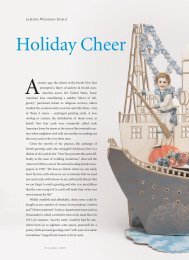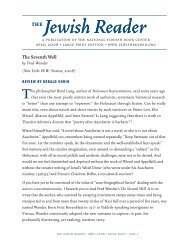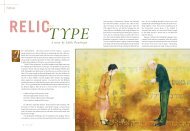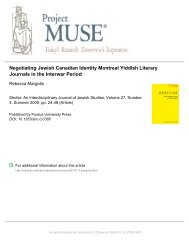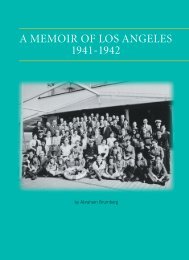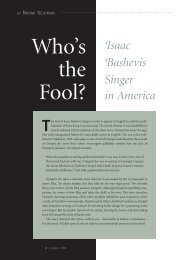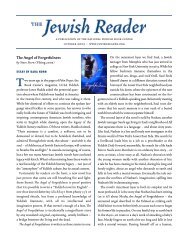The Life and Art of Boris Aronson - Yiddish Book Center
The Life and Art of Boris Aronson - Yiddish Book Center
The Life and Art of Boris Aronson - Yiddish Book Center
Create successful ePaper yourself
Turn your PDF publications into a flip-book with our unique Google optimized e-Paper software.
y C.S. O’CarrollAA LARGER S COn December 12, 1927, the Anderson Galleries o nPark Avenue opened a startling one-man show u n l i k eanything else on the New York art scene. Featuring25 miniature, spotlight-illuminated stage sets <strong>and</strong>100 painted renditions <strong>of</strong> thea-trical costumedesigns, the exhibit showcased the distinctivec reative vision <strong>of</strong> <strong>Boris</strong> <strong>Aronson</strong>, a young Russianbo rn painter, sculptor, author, dire c t o r, <strong>and</strong> stagedesigner who had arrived in the United States justfour years earlier armed, in his words, with“ p a i n t b rushes, crowded emotions, little money,<strong>and</strong> less English.”One <strong>of</strong> the plays fe a tu red in the Aron s on ex h i bi tincluded scenes set in Heaven <strong>and</strong> Hell. Another requiredan array <strong>of</strong> sets that combined the interior <strong>of</strong> a subway carwith the dreams <strong>of</strong> a passenger who falls asleep on hiscom mute home from work . Pu bl i c i ty for the ex h i bi tcelebrated the “whimsical fantasy <strong>and</strong> colorful symbolism”the artist had employed to tackle these <strong>and</strong> other u nu su a lde s i gn ch a ll en ge s .T<strong>The</strong> art <strong>of</strong> the theatrical de s i gn er is notori o u s lyephemeral, so it was remarkable enough that any set orcostume design should enjoy a life beyond the run <strong>of</strong> theplay for which it was created. What made the AndersonGalleries exhibit truly extraordinary was the fact that thisparticular designer had been plying his trade far from theglamour <strong>and</strong> prestige <strong>of</strong> the Broadway mainstream. EightTony Awards lay in <strong>Boris</strong> <strong>Aronson</strong>’s future, but at that earlypoint in his career, his innovative work had found a homeonly within the small, specialized world <strong>of</strong> <strong>Yiddish</strong> theatre.He had designed the debut productions at Unzer Teater(Our <strong>The</strong>atre) in the Bronx <strong>and</strong> the <strong>Yiddish</strong> <strong>Art</strong> <strong>The</strong>atre onthe Lower East Side. At the Schildkraut <strong>The</strong>atre <strong>and</strong> theIrving Place <strong>The</strong>atre, he had worked not only as a set <strong>and</strong>costume designer, but also as a director.During those first few years <strong>of</strong> his American career, most<strong>of</strong> New York’s Engl i s h - s peaking theatre patrons hadremained unaware <strong>of</strong> <strong>Aronson</strong>’s work. However, his boldapproach to stage design, influenced by some <strong>of</strong> Europe’smost audacious avant-garde art movements, had excitedadmiration among the city’s leading art <strong>and</strong> culture journalists.Reviewing a 1926 <strong>Yiddish</strong> <strong>Art</strong> <strong>The</strong>atre production <strong>of</strong>Avrom Goldfadn’s <strong>The</strong> Tenth Comm<strong>and</strong>ment, the influential<strong>The</strong>atre <strong>Art</strong>s Monthly critic John Mason Brown hadhailed <strong>Aronson</strong>’s “vigor <strong>and</strong> originality” <strong>and</strong> declared hiss ets <strong>and</strong> co s tumes “the bravest ex peri m ents in scen i cdesign” anywhere in New York that season.Brown, along with New York Times drama critic Broo k sAt k i n s on <strong>and</strong> <strong>Yiddish</strong> <strong>Art</strong> Th e a tre fo u n der Ma u ri ceSchwartz, was among the sponsors <strong>of</strong> <strong>Aronson</strong>’s 1927exhibit. With luminaries <strong>of</strong> that caliber as its backers, thiswas an art event calculated to put the city <strong>and</strong> the theatreworld on notice that a potent new talent had made itsentrance.<strong>The</strong> exhibit <strong>of</strong> <strong>Aronson</strong>’s <strong>Yiddish</strong> theatre designs coincidedwith his work on a production at the Civic Repertory<strong>The</strong>atre, his first commission for the English-speakingstage. His first Broadway show was still five years in thefuture. In the long career that lay ahead <strong>of</strong> him – he liveduntil 1980 <strong>and</strong> designed his final sets in 1976 – he was destinedto work with some <strong>of</strong> the greatest playwrights, performers,directors, composers, <strong>and</strong> choreographers <strong>of</strong> the20th century <strong>and</strong> to create the scenic designs for some <strong>of</strong>Broadw ay ’s most mem ora ble produ cti on s , i n clu d i n gFiddler on the Ro<strong>of</strong>, which opened in 1964 <strong>and</strong> did not closeuntil 1972 – a run <strong>of</strong> more than 3,200 performances. A fewperceptive critics had seen greatness in <strong>Boris</strong> <strong>Aronson</strong> onthe basis <strong>of</strong> his early work for the <strong>Yiddish</strong> stage, <strong>and</strong> hewould go on to prove them right decade after decade.86 wɪɴteʀ S P R I N G20052 0 0 5
L ET he <strong>Life</strong> <strong>and</strong><strong>Art</strong> <strong>of</strong> <strong>Boris</strong> <strong>Aronson</strong><strong>Aronson</strong>, one <strong>of</strong> ten children <strong>of</strong> the Gr<strong>and</strong> Rabbi <strong>of</strong> Kiev,was born in czarist Russia’s Pale <strong>of</strong> Settlement sometimebet ween 1898 <strong>and</strong> 1900. His bi rt h p l ace was a smallUkrainian town 80 miles outside <strong>of</strong> Kiev; he was about tenyears old when his father moved the family to the big city,opening up new vistas <strong>of</strong> cultural stimulation for the artisticallyinclined boy. <strong>Boris</strong> was particularly enthralled by theflamboyant painted peacock ado rning the curtain thathung in front <strong>of</strong> the stage at the Kiev Opera House.Aron s on’s wi dow, the Czech - born Lisa (Ja l owe t z )<strong>Aronson</strong>, who became his design assistant in 1943, marriedhim two years later, <strong>and</strong> worked with him on more than 20Broadway shows, recalls that her husb<strong>and</strong> didn’t talk a greatdeal about his boyhood in Russia, but said enough to conveythat he was “the black sheep in the family,” more concernedwith artistic pursuits than with his father’s world <strong>of</strong>strict religious observance.According to <strong>The</strong> <strong>The</strong>atre <strong>Art</strong> <strong>of</strong> <strong>Boris</strong> <strong>Aronson</strong>, a lavishlyillustrated 1987 volume that Lisa <strong>Aronson</strong> co-authoredwith New York Times columnist <strong>and</strong> former drama criticFrank Rich, <strong>Aronson</strong> remembered his father as a learnedman who was well versed in Russian literature, but whoknew <strong>and</strong> cared little about the visual arts. Still, the rabbipermitted his son to enroll in Kiev’s State <strong>Art</strong> School, wherethe young student quickly found himself rebelling againstthe conservatism <strong>of</strong> his instructors <strong>and</strong> looking elsewherefor inspiration.<strong>The</strong> ye a rs leading up to World War I <strong>and</strong> the Bo l s h evi kRevo luti on were a time <strong>of</strong> trem en dous arti s tic ferm ent aswell as po l i tical uph e ava l , so Aron s on was coming <strong>of</strong> a ge inan ae s t h etic cl i m a te abuzz with dari n g,ex peri m ental theori e s<strong>and</strong> styl e s . A new gen era ti on <strong>of</strong> Eu ropean painters <strong>and</strong> sculptorswas breaking dra m a ti c a lly with the past. Rej ecting su chcen tu ries-old ae s t h etic trad i ti ons as re a l i s tic repre s en t a ti on<strong>and</strong> va n i s h i n g - point pers pective , the Con s tru ctivi s t s ,Cu bi s t s , Fa uvi s t s , Futu ri s t s , Su prem a ti s t s , <strong>and</strong> other practition ers <strong>of</strong> a b s tract art were re aching for new ways to portrayhuman ex peri en ce . <strong>The</strong>se revo luti on a ry artists used distortedshapes <strong>and</strong> vivi d , u n n a tu ral co l ors to ex press spiri tual <strong>and</strong>em o ti onal re a l i ties beyond the literal truth <strong>of</strong> what thingsl oo ked like . Th ey com po s ed arra n gem ents <strong>of</strong> geom etri cforms that made no attem pt to copy or repre s ent the natu r-al worl d . Th ey fra gm en ted , mu l ti p l i ed , <strong>and</strong> overl a pped figures in order to pictu re obj ects from several angles simu l t a-n eo u s ly <strong>and</strong> to convey a sense <strong>of</strong> dynamic moti on .Exc i ted by the po ten tial <strong>of</strong> these icon ocl a s tic art movemen t s , the young <strong>Boris</strong> Aron s on found himsel f f ru s tra ted bywhat he rega rded as the fusty trad i ti onalism <strong>of</strong> the State <strong>Art</strong>S ch oo l . He was mu ch more wi lling to learn from the ava n t -ga rde artist Al ex a n d ra Ex ter, who had bef ri en ded Pa bl oPicasso while stu dying <strong>and</strong> painting abroad <strong>and</strong> hadretu rn ed to her native l<strong>and</strong> to pion eer a disti n ctively Ru s s i a nhybrid <strong>of</strong> the abstract styles she had en co u n tered el s ewh erein Eu rope . Aron s on became Ex ter ’s pupil at her studio inKi ev, t h en fo ll owed her to Mo s cow to work as her assistantwh en she took a po s i ti on as a de s i gn er at the Ka m erny<strong>The</strong>atre.In the era <strong>of</strong> the Bolshevik Revolution, the Kamerny wasspearheading a revolt against naturalistic theatre, againstplays that aspired to the faithful imitation <strong>of</strong> everyday life.Kamerny directors favored an extravagant amalgamation <strong>of</strong>multiple aesthetic elements – which might include music,dance, abstract visual art, <strong>and</strong> even circus performancetechniques – designed to give audiences an experience radicallydifferent from anything available in the <strong>of</strong>fstage world<strong>of</strong> ordinary reality. Assisting Exter with her contributions tothis vibrant, experimental theatre environment, <strong>Aronson</strong>absorbed some <strong>of</strong> the concepts <strong>and</strong> approaches that wouldcome to define his work on the American stage.Scenery at the Kamerny did not consist <strong>of</strong> two-dimensionalpainted backdrops depicting drawing rooms, city7 P A K N T R E G E R
streets, or other real-world locations. Instead, set designersthought like sculptors or architects, crafting three-dimensionalplaying spaces where the actors could move about onmultiple levels. <strong>The</strong>y arranged abstract geometric shapes<strong>and</strong> masses to construct symbolic expressions <strong>of</strong> a play’semotional essence. In keeping with the philosophy <strong>of</strong> totaltheatricality, the set <strong>and</strong> costume designer for a Kamernyplay worked intimately with the director from the earliestplanning stages <strong>of</strong> a production. <strong>The</strong> look <strong>of</strong> the play wasnot a decorative add-on, but an integral part <strong>of</strong> the show’soverall concept.An affinity for nonrepresentational stage design, a preferencefor sets that did not confine the action to a singlelevelplaying area, <strong>and</strong> a vision <strong>of</strong> the designer as a fullfledgedcollaborator with the director – all these legacies <strong>of</strong>his Kamerny experience were to have a pr<strong>of</strong>ound influenceon <strong>Aronson</strong>’s subsequent career.<strong>The</strong> Soviet Union’s hospitality to abstract <strong>and</strong> experimentalart did not last long. Socialist Realism soon becamethe nation’s <strong>of</strong>ficial aesthetic doctrine, <strong>and</strong> Stalinist purgesdealt harshly with artists whose work was deemed bourgeois,decadent, or unsuitable for government-approvedpropag<strong>and</strong>a purposes. <strong>Aronson</strong> avoided the unhappy fate<strong>of</strong> many fellow artists by fleeing the country in 1922.He settled for a short time in Berlin, where he exhibitedhis paintings <strong>and</strong> published two books, one <strong>of</strong> which was astudy <strong>of</strong> Jewish graphic art. In his native country, <strong>Aronson</strong>,temporarily using the name “Baruch <strong>Aronson</strong>,” had beenaffiliated briefly with a group <strong>of</strong> Jewish artists who lookedto traditional shtetl folk art, such as primitive woodblockprinting, <strong>and</strong> to non-representational design motifs, suchas the decorative patterns on prayer shawls <strong>and</strong> skullcaps, askeys to an explicitly Jewish style <strong>of</strong> abstract art. Now, however,<strong>Aronson</strong> used his book to argue that there was nottruly any such thing as “Jewish art,” that a people so dispersedamong many nations could not lay claim to a signatureaesthetic tradition distinct from the art <strong>of</strong> the dominantcultures around them.<strong>The</strong> other book <strong>Aronson</strong> published during his residencein Germany was about fellow artist Marc Chagall, withwhom he had fo rmed an important friendship back inRussia. Chagall was a decade older than <strong>Aronson</strong>, but thetwo had a great deal in common. Both were deeply interestedin Russian Jewish folk art, <strong>and</strong> both had exercisedtheir talents not only as painters but also as Moscow theatricaldesigners. Years later, married <strong>and</strong> living in theUnited States, <strong>Aronson</strong> would name his son Marc.<strong>The</strong> modest financial su ccess <strong>of</strong> his two books madeit po s s i ble for Aron s on to set out ac ross the At l a n ticfor New York Ci ty in 1923, a metropolis that lived in hisi m a gi n a ti on as a rom a n tic cen ter <strong>of</strong> tech n o l ogical soph i sti c a-ti on <strong>and</strong> cultu ral vi t a l i ty, “a new worl d ,” as he conceived it,wh ere an artist would be able to work “on a l a r ger, f reers c a l e .”His decision to seek his first A merican work in the<strong>Yiddish</strong> theatre was driven by practical considerations. Forthose first few years in New York, he simply didn’t haveenough English to read scripts <strong>and</strong> contracts, or even toconverse with actors <strong>and</strong> directors. Nor was he sufficientlysteeped in the look <strong>and</strong> feel <strong>of</strong> his adopted country to beconfident about his ability to express the American experiencein his designs. But, in the <strong>Yiddish</strong> theatres located inthe Bronx <strong>and</strong> on Manhattan’s Lower East Side, <strong>Aronson</strong>found a community <strong>of</strong> fellow artists <strong>and</strong> European immigrantswho shared his familiarity with the avant-garde artinnovations that were still years away from gaining accepta n ce in the com m ercial mainstream <strong>of</strong> New York’sEnglish-language theatre industry. To Broadway producers<strong>and</strong> directors <strong>of</strong> the 1920s, the young Russian’s approach tostage design was, in the words <strong>of</strong> a writer for <strong>The</strong> Nation,“an exotic <strong>and</strong> transplanted thing” that was bound to limithis appeal, notwithst<strong>and</strong>ing “<strong>Aronson</strong>’s technical pr<strong>of</strong>iciency,his intelligence, <strong>and</strong> his ingenuity.”It was not until 1932 that Broadw ay ’s imagi n a ti on caugh tup with the exo tic intell i gen ce <strong>of</strong> <strong>Boris</strong> Aron s on . He wash i red that year to de s i gn the va u devi ll e - s tyle musical revu eWalk a Little Fa s ter, the first <strong>of</strong> his many com m i s s i ons forthe musical stage . Over the next several dec ade s , Aron s on<strong>of</strong> ten found that mu s i c a l s , opera s , <strong>and</strong> ball et s , with thei ri n h erent dep a rtu res from the literal ren d i ti on <strong>of</strong> re a l i ty, weree s pec i a lly com p a ti ble with his theatrical vi s i on .Aron s on unders tood that a Broadw ay career would frequen t ly entail com promise on his part , that he would haveto come to terms with the need for re a l i s tic repre s en t a ti onin his de s i gns for certain shows . In many <strong>of</strong> the sets hede s i gn ed after leaving the <strong>Yiddish</strong> stage for the wi derworld <strong>of</strong> E n gl i s h - l a n g u a ge theatre , the lessons he hadl e a rn ed at the Ka m erny ex pre s s ed them s elves in su bt l eto u ches ra t h er than full - bl own abstracti on . For ex a m p l e ,even wh en de s i gning a pri m a ri ly re a l i s tic set , he <strong>of</strong> tens c u l pted the three - d i m en s i onal stage space by incorpora t-ing ramps <strong>and</strong> other devi ces that en a bl ed actors <strong>and</strong> directorsto invi gora te the play with acti on on more than on el evel . Because he con ti nu ed to work as a painter wh i l ep u rsuing his career in the theatre , he maintained a stron gs ense <strong>of</strong> the con n ecti on bet ween the physical re a l i ty <strong>of</strong>co l or <strong>and</strong> the em o ti onal re a l i ties <strong>of</strong> a play wri gh t’s scri pt .8 S P R I N G 2 0 0 5
“ He was a painter first <strong>and</strong> forem o s t ,” Lisa Aron s onrec a ll s . “ He alw ays said that his de s i gn was influ en ced byhis painti n g.” In many cases, this meant sel ecting a palet te<strong>of</strong> co l ors that hel ped to infuse a set with the play ’s intangible mood or essen ce .Additionally, <strong>Aronson</strong> displayed a genius for adjustingrealistic sets into something more than simply copies <strong>of</strong> thelocations they represented. His design for <strong>The</strong> Diary <strong>of</strong> AnneFrank, although it could in no way be considered abstract,did not attempt to repro duce an exact replica <strong>of</strong> theAmsterdam garret in which the Frank family hid from theNazis. Working on a relatively spacious stage, he took libertieswith the layout <strong>of</strong> the actual attic to convey a sense <strong>of</strong>close-quarters physical confinement <strong>and</strong> to capture theemotional stress arising from each individual family member’slack <strong>of</strong> privacy.<strong>Aronson</strong>’s greatest Broadway achievements, however,were his designs for productions that valued imagination<strong>and</strong> theatricality above ordinary realism. One l<strong>and</strong>markplay in this vein was the 1958 verse drama J.B., poetArchibald MacLeish’s adaptation <strong>of</strong> the <strong>Book</strong> <strong>of</strong> Job, inwhich the prosperous man who loses everything is re-imaginedas a 20th-century tycoon. <strong>The</strong> play takes place under asymbolic big top, <strong>and</strong> the roles <strong>of</strong> God <strong>and</strong> Satan are enactedby a pair <strong>of</strong> circus vendors. Long an enthusiast <strong>of</strong> circusspectacle, <strong>Aronson</strong> had featured circus themes in some <strong>of</strong>his paintings. He was thrilled by the larger-than-life designchallenge with which this play confronted him – to find avisual style encompassing both sideshow vulgarity <strong>and</strong> biblicalgr<strong>and</strong>eur, to take a seedy traveling circus as his startingpoint <strong>and</strong> render an abstract, mythologized version thatcould serve as an arena <strong>of</strong> cosmic moral conflict.To meet the challenge, he eliminated the curtain <strong>and</strong>extended the stage out over the orchestra pit in order todraw the audience closer to the action. On the reconfiguredstage, he constructed a co mplex, multilevel performanceenvironment surmounted by an expanse <strong>of</strong> canvas thatcould collapse catastrophically to represent the destruction<strong>of</strong> J.B.’s fortune <strong>and</strong> family. Winding stairs at one side <strong>of</strong> thestage rose to a structure that jutted out high above the circus-ringarea below, resembling both the pulpit from whicha preacher addresses his congregation <strong>and</strong> the platformfrom which an acrobat swings daringly into action.Aron s on said that J . B . gave him the “s cope for freedom<strong>and</strong> imagi n a ti on” that he had been seeking in the New Yorkt h e a tre for more than three dec ade s . Ha i l ed in the press as“m a j e s ti c” <strong>and</strong> “flawl e s s ,” his set for this produ cti onm a rked a tu rning point in his Broadw ay career, the start <strong>of</strong>a peri od in wh i ch he ach i eved his gre a test com m ercial su c-cess <strong>and</strong> won five <strong>of</strong> his ei ght Tony Aw a rd s .Aron s on had alw ays en j oyed re s pect from fell ow arti s t s ,but he had spent ye a rs watching other de s i gn ers l<strong>and</strong> thebl ock bu s ter assign m ents while he labored on many ae s-t h eti c a lly exc i ting but com m erc i a lly unsu ccessful playsthat cl o s ed after short ru n s . In part this was because <strong>of</strong> arestless cre a tivi ty that <strong>of</strong> ten ran ahead <strong>of</strong> wh a tever wasc u rren t ly fashion a bl e . “ It’s amazing that Broadw ay evengave him a ch a n ce , because in a sense his work was alw aysex peri m en t a l ,” Lisa Aron s on marvel s . “ He was not con s i d-ered an easy man to work wi t h . He was alw ays trying to dos om ething fresh <strong>and</strong> new.” According to Broadw ay de s i gnerKa rl Ei gs ti , who now heads the theatre de s i gn progra mat Bra n deis Un ivers i ty, s ome produ cers <strong>and</strong> directorsten ded to rega rd Aron s on as “an eccen tric Russian madma n” whose con s t a n t ly evo lving passion for new techni ques <strong>and</strong> new materials <strong>of</strong> ten flu m m oxed the shop swh ere his sets had to be bu i l t . But after the acclaim thatgreeted his J . B . s et , Broadw ay seem ed to devel op a newl evel <strong>of</strong> a pprec i a ti on for the dynamic re sults thatAron s on’s “eccen tri c” gen ius could produ ce . <strong>The</strong> 1960s<strong>and</strong> 1970s gave his career a rousing final act , with his talentsso mu ch in dem<strong>and</strong> that he tu rn ed down far morework than he was able to accept .<strong>The</strong> highlights <strong>of</strong> <strong>Aronson</strong>’s career in those decades werethe ambitious, innovative musicals on which he collaboratedwith producer/director Harold Prince – monumentalworks such as Fiddler on the Ro<strong>of</strong>, Cabaret, Zorba, Company,Follies, A Little Night Music, <strong>and</strong> Pacific Overtures. Princespoke fondly <strong>of</strong> “the peppery, combative intelligence” thedesigner brought to each new production, while <strong>Aronson</strong>praised Prince as “a director who knows my strong points<strong>and</strong> limitations . . . knows how to challenge me.”Fi d dl er, produ ced by Pri n ce , d i rected <strong>and</strong> ch oreographedby Jerome Robbins, used a script based on the stories<strong>of</strong> Sholem Aleichem <strong>and</strong> a title inspired by the work <strong>of</strong><strong>Aronson</strong>’s old friend Marc Chagall. <strong>Aronson</strong>’s design for theshow combined elements <strong>of</strong> Chagall’s fantastical, folkloricpainting style with realistic details meant to evoke thepoverty <strong>of</strong> the shtetl that is home to the family <strong>of</strong> Tevye thedairyman. Motivated by a line from Sholem Aleichem’swriting that described Tevye’s family as “a small circle withinthe larger community <strong>of</strong> the town,” <strong>Aronson</strong> placed hisset on two large turn-tables, one revolving <strong>of</strong>f-center insidethe other, that moved the acto rs <strong>and</strong> scenery about thestage. Robbins seized on the circle motif for much <strong>of</strong> hischoreography <strong>and</strong> for striking visual moments in whichactors dispersing from a circular stage picture symbolized9 P A K N T R E G E R
the evaporation <strong>of</strong> a traditional way <strong>of</strong> life.For Cabaret, set in the Berlin that <strong>Aronson</strong> had knownin the 1920s, the designer adopted an edgy, grotesque styleto express the chaotic spirit <strong>of</strong> Weimar Germany <strong>and</strong> thelooming menace <strong>of</strong> Nazism. Moving away from the stagemusical tradition in which each song <strong>and</strong> dance numberadvances the story incrementally, Cabaret situated much <strong>of</strong>its action in a garish nightclub with a tinsel stage curtain<strong>and</strong> a marquee <strong>of</strong> huge cursive letters flashing on <strong>and</strong> <strong>of</strong>f.<strong>The</strong> music <strong>and</strong> choreography created spectacles that hadless to do with conventional narrative than with satiricalsocial commentary <strong>and</strong> expression <strong>of</strong> the play’s thematicessence. One particularly effective feature <strong>of</strong> <strong>Aronson</strong>’sCabaret set was an enormous mirror that reflec ted theaudience as the theatre filled up before the performance,then lifted into the air <strong>and</strong> changed its angle to provide areflection <strong>of</strong> the action on the stage.Co m pa ny, wh i ch open ed in 1970 <strong>and</strong> pre s en ted a ra t h eru n s ym p a t h etic vi ew <strong>of</strong> u rban life <strong>and</strong> marital rel a ti on s h i p sin the New York Ci ty <strong>of</strong> its day, m ay have been the crown i n gach i evem ent <strong>of</strong> Aron s on’s career. Th e a tre historian Ju n eMa m a n a , who made Aron s on the su bj ect <strong>of</strong> h er 1997 Tu f t sUn ivers i ty doctoral dissert a ti on , wri te s , “O f a ll the showsthat he co ll a bora ted on with Pri n ce , Aron s on felt thatCo m pa ny em bod i ed his best work .” All silvery met a l , cl e a rp l a s ti c , <strong>and</strong> ri ght angles inspired by Ma n h a t t a n’s geogra phy<strong>and</strong> arch i tectu re , the Co m pa ny s et hoi s ted actors up <strong>and</strong>down in a pair <strong>of</strong> el eva tors <strong>and</strong> placed them inside box l i kep l aying areas that ex pre s s ed what Lisa Aron s on <strong>and</strong> Fra n kRi ch de s c ri be as “the bleak mood <strong>of</strong> a l i en a ted con tem pora ryNew Yorkers , who are at on ce tra pped <strong>and</strong> ex po s ed in thei rglass en cl o su re s .” Using slide proj ecti ons against a gi a n tc ycl orama in lieu <strong>of</strong> s cene ch a n ge s , the de s i gn won Aron s onthe sixth <strong>of</strong> his ei ght Tony Aw a rds <strong>and</strong> bro u ght him some <strong>of</strong>his most gl owing revi ews . Raving abo ut Aron s on’s set in theNew Repu bl ic, S t a n l ey Kauffman decl a red , “ In a dec i s ivew ay, it ‘m a ke s’ the show. <strong>The</strong> ultra-hip tone <strong>of</strong> Co m pa nyrests on the work <strong>of</strong> this seven ty - ye a r-old de s i gn er.”<strong>Aronson</strong> continued to create critically acclaimed, awardwinningwork well into his eighth decade. His notableachievements in the 1970s included the deceptively simpleset for Follies, which took place on the empty stage <strong>of</strong> a theatre slated for dem o l i ti on , <strong>and</strong> the Ka bu k i - i n flu en ceddesign <strong>of</strong> Pacific Overtures, which dealt with the 19th-centurycultural collision between the young United States <strong>and</strong>the ancient, long-isolated nation <strong>of</strong> Japan. Like so many <strong>of</strong>his other assign m en t s , e ach <strong>of</strong> these produ cti ons wasremarkable for the freshness <strong>of</strong> its approach, for the artist’srefusal to repeat something that had worked for him in thepast. <strong>Aronson</strong> had always insisted that he did not aspire tobe known for a characteristic style that recurred from oneshow to the next. He wanted instead to be creatively“reborn” with each new production.He won his final Tony Aw a rd for Pa ci fic Overtu re s in 1 9 7 6 ,the same year that Fi d dl er on the Ro<strong>of</strong> was revived with hisori ginal set . He also de s i gn ed his final ball et that ye a r, co ll a borating with dancer / ch oreogra ph er Mikhail Ba rys h n i kov ona Wa s h i n g ton , D. C . , produ cti on <strong>of</strong> <strong>The</strong> Nu tcra cker.Ba rys h n i kov had defected from the Sovi et Un i on some ye a rse a rl i er, <strong>and</strong> he <strong>and</strong> Aron s on were able to con fer in Russian ast h ey bra i n s torm ed the look <strong>of</strong> the show.As he had thro u gh o ut his theatre career, Aron s on continu ed to paint in the final ye a rs <strong>of</strong> his life . He died inNovem ber 1980. <strong>The</strong> fo ll owing su m m er, Broadw ay welcomed yet another Fi d dl er on the Ro<strong>of</strong> reviva l . O n ce aga i n ,the program credit re ad , “S cenic De s i gn by Bori sAron s on .”C. S. O’Carroll is a writer <strong>and</strong> actor who has performed ontheatre <strong>and</strong> comedy club stages in more than half the 50states <strong>and</strong> has published articles on show business topics innumerous newspapers <strong>and</strong> magazines.10 S P R I N G 2 0 0 5
11 P A K N T R E G E R



